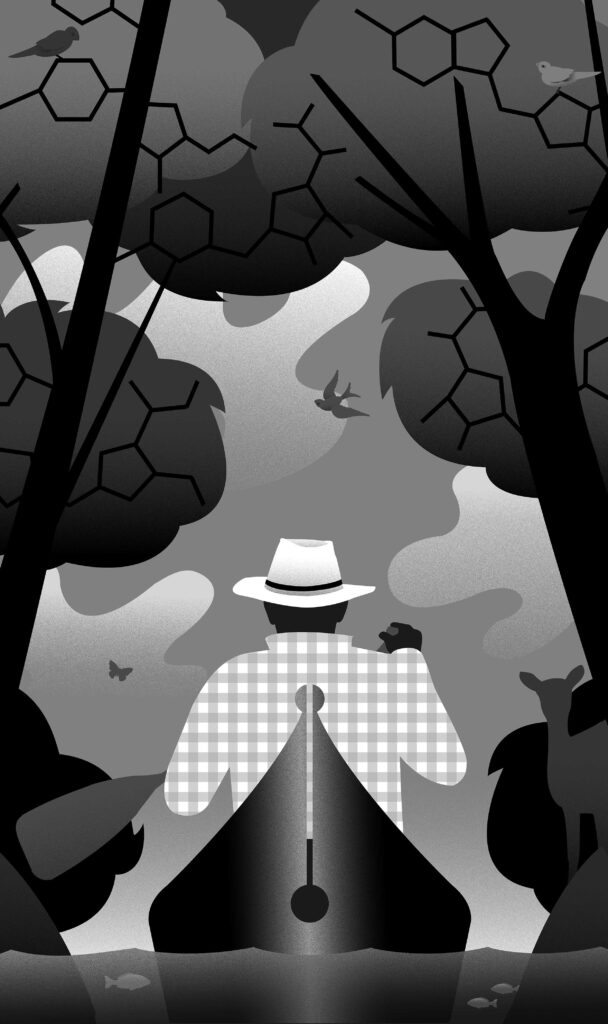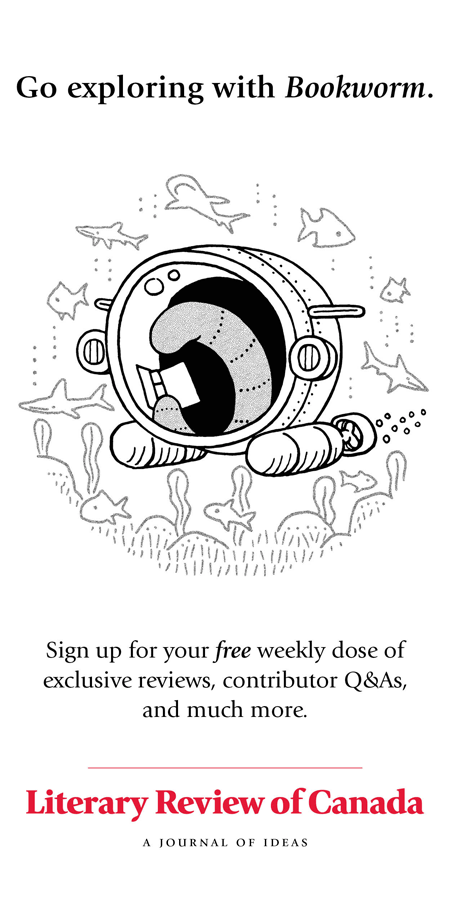The discourse about climate change, with some 3,000 books published in 2023 alone, is plainly overwhelming. Those hungering for a more palatable bite might sample Lorne Fitch’s Travels up the Creek, which focuses on environmental degradation in Alberta. Like other climate change books, this one aims for an awakening among readers. For Fitch, this is a cri de cœur to protect what remains and perhaps mitigate some of the damage. “We should be scared, scared spitless in fact, of our current course,” he writes in his introduction.
An award-winning conservationist with a penchant for Aldo Leopold quotes, Fitch worked as a biologist with the Alberta Forest Service for thirty years. His storytelling skills, which render science accessible and meaningful, are central to his writing for conservation organizations and popular audiences alike. As with his first book, Streams of Consequence: Dispatches from the Conservation World (part of that 2023 crop), Travels up the Creek is made up of linked essays, conversational and occasionally humorous. At one point, Fitch adopts the persona of an alien visitor who is reporting on earthlings’ “uncharacteristic blindness to their own survival, with their actions to overuse and overheat their planet.” Later he provides a safety briefing for the celestial body we ride on. These devices are amusing, and his stories are often compelling, though frequent repetition of details and lessons quickly wears thin and is counterproductive to persuasion.

Battling the current with science and pen.
Neil Webb
The book’s first chapter opens with a meeting of Cows & Fish, a non-governmental stewardship group that Fitch co-founded in 1992. As disgruntled landowners in central Alberta lament the state of their local waterfront, a woman volunteers to replace her septic system: “She’s realized that an already overloaded lake cannot stand any more nutrients.” At another meeting, a rancher who previously felt singled out —“This is B.S.!”— tells Fitch he “spent a long time (almost a year) thinking about the information we had provided” and would now “implement several grazing management changes.”
Watersheds like the rancher’s have been ravaged throughout Alberta, and the culprits are many: excess nutrients from cities and agriculture; debris and damage from industrial logging, oil production, and coal mining; the proliferation of roads and recreation trails. Fitch describes a lack of oversight, particularly in commercial logging, where the industry itself assesses potential harm to waterways. In the headwaters of the Oldman River, for example, a “special place called Hidden Creek” was targeted a decade ago. “It was left to industry to define whether the tributary streams were permanent or intermittent and what protection was required,” Fitch writes. “How this was done in winter, under snow cover, is a mystery.” Two years after the area was logged, there was an 80 percent drop in bull trout nests. Other waterways are laden with mud and sediment, often in a chemical stew that solidifies and makes it difficult for fish to nest. Province-wide, native cutthroat trout are absent from 94 percent of their historic range, while bull trout no longer swim in 70 percent of theirs in the Oldman watershed.
Fitch discounts “clean coal” and “ethical oil,” but it’s puzzling that he only briefly mentions the oil sands. Open pits of toxic waste recently overflowed, spilling 5.3 million litres of tailings into northern muskeg and forest. Surely this is Alberta’s largest source of environmental degradation. That’s not to say Fitch hasn’t taken action in other areas. When Amoco wanted to extract natural gas near the Whaleback —“even though the site contained critical elk winter range”— he and his colleagues found a way to dodge a departmental gag order: “Fish and Wildlife biologists reached out to a like-minded individual within the [Energy Resources Conservation Board] and had him make a verbal request (nudge, nudge, wink, wink) to the Fish and Wildlife Division about what would be needed to assess the environmental impacts of the proposed development.” A hearing was held and the project was blocked. Another time, Fitch met with biologists hired by an oil company who claimed that a proposed well wouldn’t affect a stream — one he had studied extensively. He ripped their slim report in half. Fitch also confronted his own employer. “Leaving forests to the care of the Forest Service is akin to leaving a pig under the protection of the butcher,” he explains. “All that is left is the squeal.” Surprisingly, Fitch was never fired (he retired in 2006), but there were reprisals: travel requests were denied, and he was excluded occasionally from meetings.
While Fitch takes issue with Alberta’s “open for business” credo and calls for full cost accounting of its cut-and-run policies, he lauds the scientific work of some, including hydrogeologists. He adapts the term “combat biology” to mean the “application of science to find solutions to problems and the use of reliable, factual evidence to guide decisions.” This entails understanding who controls the levers of power and evoking in the general population feelings of nostalgia, empathy, guilt, and stewardship. But if the “application of science” is key, it’s ironic that Fitch includes no references, index, or bibliography in his book.
Full scientific accounting of species impacted by development is relatively new, and there are limits to the data. At times Fitch turns to reports from explorers and settlers, but he doesn’t mention the traditional knowledge of First Nations, which seems oddly short-sighted. He does, however, mention anecdotal ways of knowing, which can come through trial and error. Fitch and his colleagues once spent seven years bolstering trout populations by building several hundred habitat structures. Before these could be evaluated properly, though, they were mostly washed away by flooding. Other interventions have been more successful, including artificial beaver dams, which sometimes attract actual beavers that then take over, and the reintroduction of bison to Grasslands National Park, in Saskatchewan. Those animals blaze winter trails that enable pronghorn antelope to forage instead of starving.
The good news is that scientists are getting better at defining thresholds that signal the imminent collapse of species. The bad news: they are too often ignored. Even as Alberta continues to favour economic growth over environmental protection, Fitch urges everyone to live lightly and to speak out when governments, corporations, and individuals act selfishly. “The carefree good times are gone,” he argues. Climate change activists would no doubt agree.
Barbara Sibbald is a journalist and fiction writer who gets out in nature as often as possible.

